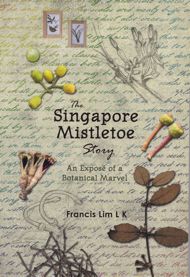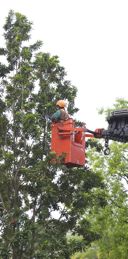The Singapore Mistletoe Story: An expose of a Botanical Marvel has just been published by Carnegale Press. Authored by Singapore’s snake man Francis Lim, it gives a fascinating story of these semi-parasitic plants in Singapore. The idea of a mistletoe book was hatched when Francis was handling snakes in the Singapore Zoological Gardens. Since then he has been to all corners of the main and offshore islands in his mission to study and collect all the 16 recorded native species.
The book includes an account of the rich legends and folklore behind these fascinating plants, their role in folk medicine, the different host plants as well as their biology. It is available at Select Books in Tanglin Shopping Centre for SGD $22 without GST.
Most people are not comfortable with mistletoes, considering them as parasitic plants. Their presence is always viewed as detrimental to the health of the host plants. So they are pruned whenever encountered. But mistletoes are semi-parasites, tapping the host plants of only water and nutrients. Their green leaves tap the sun to manufacture their own food.
So, is there a necessity to remove all mistletoes from our roadside and garden trees? Definitely not! Only when the growth of the mistletoes is excessive is it necessary to remove them. Even then, selective removal should be practiced. After all, these plants are a magnet to birds such as sunbirds and flowerpeckers, not to mention parakeets and hanging parrots that visit for the flower nectar and the succulent fruits LINK.
This is where Francis’ book can play an important role in public education. Singapore aspires to be a “City in a Garden” – with wildlife flourishing in our urban areas. Thus encouraging more mistletoes rather than removing them from our trees, would be the most sensible thing to do. This will bring more wildlife, especially birds, to every corner of the main island.
Years ago, epiphytes like stag’s horn ferns (Platycerium coronarium) and pigeon orchids (Dendrobium crumenatum) were regularly removed from our roadside trees under the misconception that they contributed to weakening the trees branches and/or encouraging mosquito breeding. Subsequently when perceptions changed, epiphytes were actually put back onto our trees, tied securely with strings. The images above show, left to right, stag’s horn fern on a tree, “cleaning” of trees, tender to purchase stag’s horn ferns and placing back a fern onto a branch of a tree.
We managed to convince the authorities that epiphytes do not damage our trees. We should now be able to convince people, with Francis’ book, that semi-parasitic mistletoes, when properly managed, can enhance the quality of our “City in a Garden.”
YC Wee
Singapore
November 2011














3 Responses
I would love to purchase this book. However, The only source I can find the shipping Airmail is more than the book itself. I am in the USA. Anyone there willing to send it slower than airmail? Thanks, Tammy